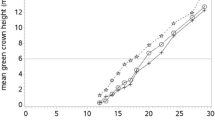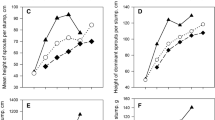Abstract
The effects of stand density on increment and branch properties were studied in three spacing experiments of Norway spruce [Picea abies (L.) Karst.]. The stand densities ranged from 350 stems ha−1, regarded as open-grown trees, up to 1,600 stems ha−1, corresponding to the density recommended for forestry practice. Properties of all the branches were measured from the stem apex downwards. The study material included a total of 5,661 branches from 45 trees. Increasing stand density resulted in a decrease in radial increment as well as shorter and narrower crowns, but it had no effect on height increment. The average number of spike knots per tree was 0.87, 0.27, and 0.33 in densities of 350, 700 and 1,600 ha−1, respectively. Additionally, in the widely spaced stands of 350 stems ha−1, the fraction of trees having spike knots was high (over 50%). At a density of 1,600 ha−1, the sample trees had somewhat less branches in a whorl compared with the more widely spaced plots. The most pronounced effect of stand density was the increase in branch diameter with decreasing stand density. At a density of 350 ha−1, the maximum branch diameter of all the sample trees exceeded the diameter limit of quality class B in the European quality requirements for round wood. The results give some indication that trees subjected to severe competition would produce smaller branches per unit of crown projection area. However, the possibilities for reducing branch dimensions relative to stem and crown size through competition appear quite restricted.




Similar content being viewed by others
References
Abetz P (1976a) Contribution to tree growth: the h/d-ratio—more than an indicator of slenderness (in German). Forst Holzwirt 19:389–393
Abetz P (1976b) Reactions to enlarged growing space and consequences for the selective thinning in Norway spruce (in German with English summary). Allg Forst-u Jagdztg 147:72–75
Abetz P (1987) The “Solitary program 1987”. A contribution to a forestry related risk control (in German). Allg Forstztg 45:1172
Abetz P, Lässig P (1989) Great echo to the Solitary program 1987 (in German). Allg Forstztg 27:714–716
Abetz P, Klädtke J (2002) The target tree management system (in German with English summary). Forstw Cbl 121:73–82
Abetz P, Unfried P, Merkel O (1984) Spruce spacing experiments in the forest district of Riedlingen/ Danube (in German with English summary). Allg Forst- u Jagdztg 155:89–110
Anon (1998a) Qualitative classification of softwood round timber—Part 1: spruces and firs. European Committee for Standardization. prENV 1927-1. Bruessels. pp 7
Anon (1998b) European norm for sawn timber, EN 1912. European Committee for Standardization. Bruessels
Anon (1998c) European norm for sawn timber, EN 388. European Committee for Standardization, Bruessels
Anon (2003) Timber assortment according to carrying capacity, softwood timber (in German). Beuth, Berlin
Assmann E (1970) The principles of forest yield study. Pergamon Press Ltd., Oxford
Becker G, Seeling U (1998) Holzqualität der Fichte. Allg Forstz 53:434–435
Bergquist J, Bergström R, Zakharenka A (2003) Responses of young Norway spruce (Picea abies) to winter browsing by roe deer (Capreolus capreolus): effect of height growth and stem morphology. Scand J For Res 18:368–376
BW-LFV (1997) Guidelines for the tending of young stands (in German). Ministry of Rural Space, Nutrition, Agriculture and Forestry, Forest Service of Baden-Württemberg. Stuttgart, pp 16
BW-LFV (1999) Guidelines of general forest development types (in German). Ministry of Rural Space, Nutrition, Agriculture and Forestry, Forest Service of Baden-Württemberg. Stuttgart, pp 54
Carter RE, Miller IM, Klinka K (1986) Relationships between growth form and stand density in immature Douglas-fir. For Chron 62:440–445
Colin F, Houllier F (1992) Branchiness of Norway spruce in northeastern France: predicting the main crown characteristics from usual tree measurements. Ann Sci For 49:511–538
Eriksson H, Karlsson K (1997) Effects of different thinning and fertilization regimes on the development of Scots pine (Pinus sylvestris (L.)) and Norway spruce (Picea abies (L.)) Karststands in long-term silvicultural trials in Sweden. Department of Forest Yield Research, Swedish University of Agricultural Sciences, Report 42 (in Swedish with English summary)
FR-ONF (1996) Silviculture of Norway spruce. State Forest Service of France (in French). Bull Tech 31:43–51
Forward DF, Nolan NJ (1961a) Growth and morphogenesis in the Canadian forest species. IV. Radial growth in branches and main axis of Pinus resinosa Ait. under conditions of open growth, suppression, and release. Can J Bot 39:385–409
Forward DF, Nolan NJ (1961b) Growth and morphogenesis in the Canadian forest species. IV. Further studies of wood growth in branches and main axis of Pinus resinosa Ait. under conditions of open growth, suppression, and release. Can J Bot 39:411–436
Grote R, Pretzsch H (2002) A model for individual tree development based on physiological processes. Plant Biol 4:167–180
Hasenauer H (1997) Dimensional relationships of open-grown trees in Austria. For Ecol Manage 96:197–206
Heikinheimo O (1953) On natural pruning of tree stems. Commun Inst For Fenn 41(5):139
HE-LFV (1999) Guidelines and recommendations for close to nature forest management in the Hessian state forests (in German). Hessian Ministry of Environnement, Agriculture and Forests. Wiesbaden p 91
Kantola A, Mäkelä A (2004) Crown development in Norway spruce (Picea abies (L.) Karst.). Trees 18:408–421
Kellomäki S (1983) Strength of Scots pine branches (in Finnish with English summary). Silvae Fenn 17:175–182
Kellomäki S, Oker-Blom P (1983) Canopy structure and light climate in a young Scots pine stand. Silvae Fenn 17:1–21
Kenk G (1988) Management of Norway spruce without precommercial thinnings? The example of a 115 year old stand in the growth region of the Suabian Alb (in German). Allg Forstztg 30:837–839
Kenk G (1990) Wide spacing in Norway spruce stands. Development and consequences (in German with English summary). Forstw Cbl 109:86–100
Kenk G, Unfried P (1980) Branch base diameters in stands of Douglas fir (in German with English summary). Allg Forst-u Jagdztg 151:201–210
Kern KG (1962) Comparative measurement of precipitation in pure Norway spruce stands and in trial plots in silver fir/Norway spruce/Beech selections forests(in German). Schriftenreihe der Forstl Abt der Universität Freiburg, Germany 1:255–265
Kozlowski TT, Pallardy SG (1997) Physiology of woody plants. Academic Press, San Diego, CA
Kramer H, Jünemann D (1985) The influence of heavy individual and schematic thinning on the growth of young spruce stands (in German with English summary). Forstarchiv 56:253–258
Kuuluvainen T (1991) The effect of two growth forms of Norway spruce on stand development and radiation interception: a model analysis. Trees 5:171–179
Lässig R (1991) To the growth of Norway spruce (Picea abies (L.) Karst.) in southwestern Germany. PhD. thesis. Faculty of Forestry. University of Freiburg. Freiburg, Germany. p 136
Maguire DA, Moeur M, Bennett WS (1994) Models for describing basal diameter and vertical distribution of primary branches in young Douglas-fir. For Ecol Manage 63:23–55
Maguire DA, Johnston SE, Cahill J (1999) Predicting branch diameters on second-growth Douglas-fir from tree-level descriptors. Can J For Res 29:1829–1840
Mäkelä A (1997) A carbon balance model of growth and self-pruning in trees based on structural relationships. For Sci 43:7–24
Mäkinen H (1999) Effect of stand density on radial growth of branches of Scots pine in southern and central Finland. Can J For Res 29:1216–1224
Mäkinen H (2002) Effect of stand density on the branch development of silver birch (Betula pendula Roth) in central Finland. Trees 16:346–353
Mäkinen H, Colin F (1999) Predicting the number, death, and self-pruning of branches in Scots pine. Can J For Res 29:1225–1236
Mäkinen H, Isomäki A (2004) Thinning intensity and growth of Norway spruce stands in Finland. Forestry 77:349–364
Mäkinen H, Ojansuu R, Sairanen P, Yli-Kojola H (2003) Predicting branch characteristics of Norway spruce (Picea abies (L.) Karst.) From simple stand and tree measurements. Forestry 76:525–546
Merkel O (1967) The effect of tree spacing on branch sizes in spruce (in German with English summary). Allg Forst-u Jagdztg 138:113–125
Niemistö P (1995) Influence of initial spacing and row-to-row distance on the crown and branch properties and taper of silver birch (Betula pendula). Scand J For Res 10:235–244
Nilson U, Gemmel P (1993) Changes in growth and allocation of growth in young Pinus sylvestris and Picea abies due to competition. Scand J For Res 8:213–222
Oliver CD, Larson BC (1996) Forest Stand Dynamics. John Wiley and Sons, New York
Persson B, Persson A (1997) Variation in stem properties in a IUFRO 1964/1968 provenance experiment in southern Sweden. Silvae Genet 46:94–101
Prescher F, Ståhl EG (1986) The effect of provenance and spacing on stem straightness and number of spike knots of Scots pine in south and central Sweden. Stud For Suec 172:12
Pretzsch H (2005) Stand density and growth of Norway spruce (Picea abies [L.] Karst.) and European beech (Fagus sylvatica L.): evidence from long-term experimatal plots. Eur J For Res 124(3):193–205
Protz CG, Silins U, Lieffers VJ (2000) Reduction in branch sapwood hydraulic permeability as a factor limiting survival of lower branches of lodgepole pine. Can J For Res 30:1088–1095
Remphrey WR, Powell GR (1984) Crown architecture of Larix laricina saplings: quantitative analysis and modelling of (nonsylleptic) order 1 branching in relation to development of the main stem. Can J Bot 62:1904–1915
Röhle H, Huber W (1985) Investigations on the methods to measure crown radii and on the calculation of crown projection areas (in German). Forstarchiv 56:238–243
SAS Institute Inc (2004) SAS/STAT 9.1. User’s Guide. SAS Institute Inc.,Gary, NC pp 5121
Seeling U, Reck P, Becker G, Bücking M (2004) Quality of veneer and sawn timber, produced of pruned, high dimension Norway spruce trees with long crowns. Forst Holz 59:63–68
Seifert T, Pretzsch H, Bücking M (2003) Coppice with spruce from high forest? Part II: year ring width, stem taper and branchiness of long crowned Norway spruce. Forst Holz 58:473–477
Stenberg P, Smolander H, Spruger D, Smolander S (1998) Shoot structure, light interception, and distribution of nitrogen in an Abies amabilis canopy. Tree Physiol 18:759–767
Valentine HT, Ludlow AR, Furnival GM (1994) Modeling crown rise in even-aged stands of Sitka spruce or loblolly pine. For Ecol Manage 69:189–197
Velling P (1988) The relationships between yield components in the breeding of Scots pine. PhD. thesis, University of Helsinki, Helsinki, Finland
Vestøl GI, Colin F, Loubére M (1999) Influence of progeny and initial stand density on the relationship between diameter at breast height and knot diameter of Picea abies. Scand J For Res 14:470–480
Acknowledgements
We thank Christian David Franke, Klaus Freyler, and Oswald Keller for the field work. We are also grateful to Klaus Freyler for measuring annual radial increments and Stuart Dedrick for revising the language.
Author information
Authors and Affiliations
Corresponding author
Additional information
Communicated by Jürgen Bauhus
Rights and permissions
About this article
Cite this article
Mäkinen, H., Hein, S. Effect of wide spacing on increment and branch properties of young Norway spruce. Eur J Forest Res 125, 239–248 (2006). https://doi.org/10.1007/s10342-006-0115-9
Received:
Accepted:
Published:
Issue Date:
DOI: https://doi.org/10.1007/s10342-006-0115-9




